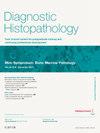Head and neck mucosal manifestations of microbial infection: clinical presentation, histological features and diagnostic aids
引用次数: 0
Abstract
Manifestations of microbial infection in the head and neck mucosa present significant challenges in diagnosis, often due to their non-specific clinical, imaging and histological appearances. Their presentation as ulcerated or necrotic lesions, combined with lymphadenopathy mimic malignant processes, resulting in further challenges in diagnosis. Additionally, the need for a microbial infection diagnosis is overshadowed by the urgency to confirm or exclude a cancer diagnosis, resulting in ancillary investigations catering mostly to the latter. The necessity for accurate and timely diagnosis of microbial infections is emphasized, especially for acute necrotizing infections due to anatomical proximity to vital structures of the cranial cavity and neck. To enable this, a reasonable level of experience and knowledge of the clinical and histological appearances of a range of microbial infections presenting in the head and neck region is essential. Histological skills, together with emphasis on detailed clinical and imaging features, and history should enable accurate diagnosis and targeted management. The salient features of a selection of viral, fungal, bacterial and protozoan infections presenting in the head and neck mucosal sites, their differential diagnoses and investigative tools are discussed.
头颈部粘膜微生物感染的临床表现、组织学特征及诊断辅助
头颈部粘膜的微生物感染往往由于其临床、影像学和组织学表现的非特异性而给诊断带来巨大挑战。它们表现为溃疡或坏死性病变,并伴有淋巴结肿大,模仿恶性过程,给诊断带来了更多挑战。此外,确诊或排除癌症诊断的紧迫性掩盖了对微生物感染诊断的需求,导致辅助检查主要用于后者。强调准确及时诊断微生物感染的必要性,尤其是急性坏死性感染,因为其解剖结构接近颅腔和颈部的重要结构。为此,对头颈部各种微生物感染的临床和组织学表现有一定的经验和知识是必不可少的。组织学技能以及对详细的临床和影像学特征以及病史的重视,应有助于准确诊断和有针对性的治疗。本讲座讨论了出现在头颈部粘膜部位的部分病毒、真菌、细菌和原生动物感染的显著特征、鉴别诊断和检查工具。
本文章由计算机程序翻译,如有差异,请以英文原文为准。
求助全文
约1分钟内获得全文
求助全文
来源期刊

Diagnostic Histopathology
Medicine-Pathology and Forensic Medicine
CiteScore
1.30
自引率
0.00%
发文量
64
期刊介绍:
This monthly review journal aims to provide the practising diagnostic pathologist and trainee pathologist with up-to-date reviews on histopathology and cytology and related technical advances. Each issue contains invited articles on a variety of topics from experts in the field and includes a mini-symposium exploring one subject in greater depth. Articles consist of system-based, disease-based reviews and advances in technology. They update the readers on day-to-day diagnostic work and keep them informed of important new developments. An additional feature is the short section devoted to hypotheses; these have been refereed. There is also a correspondence section.
 求助内容:
求助内容: 应助结果提醒方式:
应助结果提醒方式:


